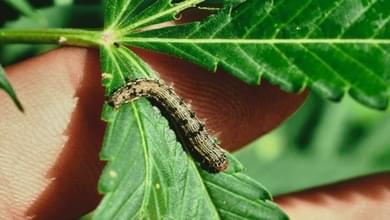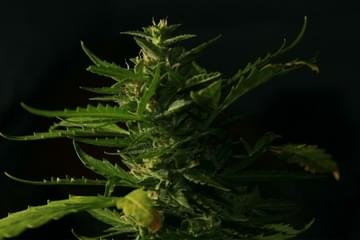
Stoney Critters: How to Deal with a Caterpillar Infestation on Cannabis Plants
Published on 12/18/22
Now that the cannabis harvest season has ended and winter is in full effect, growers are reflecting on their highs and lows of the year. For some new and experienced outdoor growers, you may have spotted some little critters on your plants this past grow cycle. Luckily, with some reading and education, pests can be kept away from your precious buds.
As it turns out, however, you and all the other humans you happen to know aren't the only creatures interested in your cannabis crop! Your cannabis crop is bound to attract a wide range of critters, but today we're going to focus on one that you might have missed even if you were looking for them; caterpillars.
No matter how you look at it, caterpillars in buds are never a good thing. These creepy little crawlers have voracious appetites, can easily be overlooked due to their natural camouflage, and can wreck your cannabis plants if you don't properly account for them. Thankfully we here at Where's Weed have your back when it comes to any, and all things weed, caterpillars, and home growing in general.
With that in mind, this article is going to deep dive into exactly what types of caterpillars to keep an eye out for when growing your plants outside, what to do if you happen to come across some caterpillar worms on your precious pot, and how to get rid of caterpillars on weed plants quickly and effectively!
Which Pests to Look Out For?
For those who have been living under a rock or have yet to spend much time outside, identifying a caterpillar on your plants could be more challenging than it would appear. Before we got too in-depth on anything and everything bud worms-related, we thought it would be valuable to give you some insight on which caterpillars to look for while growing.
At their most basic level, caterpillars are the soft-bodied larvae stage of the butterfly's life cycle. They are squishy little things with long, segmented bodies, six legs, and a hefty appetite for plant life. If left alone, they'll carve up your plants like Thanksgiving dinner and leave you with a lower quality harvest than expected.
Since there are so many different bug species in all other regions of the world, it's tough to put the finger on exactly which type of caterpillar you're most likely to see. However, we can give a general warning for some common caterpillars that you should watch out for this fall.
First, the hemp borer (Grapholita delineana) is a menace to your plants. This little critter loves cannabis stems, burrowing into them and sucking the marrow within. If left untouched, this means dead cannabis plants.
Two other usual suspects are the so-called vampire moth caterpillars (Spodoptera exigua), silver Y moth caterpillars (Autographa gamma), and cotton bollworm caterpillars (Helicoverpa armigera). All three love showing up during your plant's flower phases, munching on your buds, and ripping into your grow right before it's finally time to harvest.
You should keep your eyes peeled for these little buggers and other insect pests like aphids and mites if you want to get the best out of your plants!
How to Spot a Caterpillar Infestation
 Forestry Images, Picture by Whitney Cranshaw of Colorado State University
Forestry Images, Picture by Whitney Cranshaw of Colorado State UniversitySo now that you know which types of caterpillars to keep your eyes peeled for, how can you tell if they're around? After all, it would be impossible for you to watch your plants at all times if you're growing outside, so knowing how to floor the breadcrumbs and pick up on little things is essential.
Here's a quick round-up of some telltale signs you might be dealing with a caterpillar problem:
Stem and Leaf Damage
Remember that voracious appetite we mentioned before? Well, the best sign is that something eating your plants speaks for itself. Little holes in your plant's leaves can be a heartbreaking sign that your precious buds might be in peril. If you've caught it early enough, there's still time to act, but your plants being actively eaten isn't a great sign.
Stunted Plant Growth
If you've ever grown anything at home, you know how satisfying and encouraging it is to see your plants grow. However, if you're dealing with an infestation, this progress is slower than usual due to the energy your plants need to use to fix the damage the caterpillars cause.
Caterpillar Poop
While this one might seem like a no-brainer, it's easier to miss than you'd think. Usually showing up on plants in the form of little black specs, caterpillar poop on your cannabis is nasty for multiple reasons. Not only can smoking caterpillar poop-covered cannabis make you sick, but it also means you're dealing with a serious infestation.
How to Deal with a Caterpillar Infestation
If you see signs of caterpillars, don't freak out. There's likely still time to save your plants and harvest, but you'll need to be swift and decisive. Here are some ways to get rid of that lingering caterpillar infestation:
Spray Your Plants
While it might not be ideal due to the chemicals and such, the quicker you kill the caterpillars feasting on your plants, the sooner you'll be able to rest easy. While an ounce of prevention is for sure worth a pound of cure, now is the time for fast and decisive action. We recommend BT Caterpillar Spray (or something similar) since it's quick, effective, and safe for humans.
Hand-Pick Those Caterpillars
If you're uncomfortable spraying anything on your plants, then your best bet is to remove the caterpillars you see manually by hand. Throw on a glove, grab a mason jar with a lid, and go ahead and start picking the little buggers off your plants. The biggest challenge of this method is that many species are nocturnal, meaning you'll need to make some trips outside while the sun is down to root out the infestation effectively.
How to Get Rid of Caterpillars on Plants Naturally
If you're still early in your growing season, or you're just lamenting your mistakes and planning for next year, you have a wide variety of natural options you can opt for to keep caterpillars off of your plants in the future.
Here's a list of some of our favorites:
Set Up Bird Feeders
The best way to get rid of bugs is for their natural predators to be nearby. To ensure that, go ahead and put up some bird feeders near your crops to attract bird species. Goldfinches, sparrows, and robins all feast on caterpillars, picking them off your plants for you without disrupting them otherwise. The smartest growers out there know how to use nature to their advantage!
Plant Herbs
Plant thyme and basil if you're looking for a pesticide-free, natural deterrence. Both are excellent insect repellants with a million uses aside from just fending off bugs. Growing herbs is often a smart and fragrant option, but there's also nothing like cooking with fresh garden herbs to add a splash of flavor to your food. It's a win-win!
Set Up Some Screens
While this step might require a little bit of manual labor, the protection it will provide your plants will be a significant plus. Setting up some insect screen that butterflies and moths can't fit through goes a long way to keeping your plants from becoming a meal. After all, if the insect's eggs can't be laid directly on your plant thanks to the screens, you've put up a massive layer of protection for your plants. As we mentioned before, an ounce of prevention is worth a pound of cure!


















